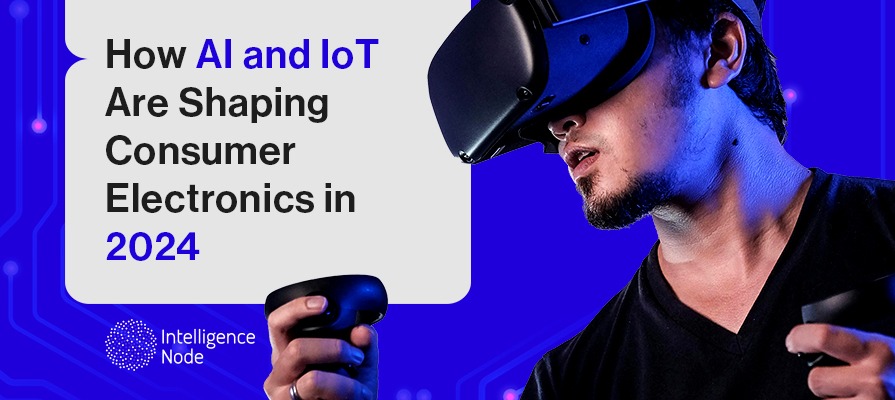The consumer electronics landscape is rapidly evolving, driven by a mix of innovation, changing consumer preferences, and technological advancements. Reports show that this year, 78.3% of total consumer electronics sales will come from brick-and-mortar stores, and online sales will account for the remaining 21.7%. Currently, the global Consumer Electronics market is set to achieve revenues totaling approximately US$1,046.0 billion. As the industry moves beyond the turbulence of previous years, marked by supply chain disruptions and inflationary pressures, the focus is now on delivering value-driven, convenient products that enhance everyday living. This growth is underpinned by increasing consumer demand for cutting-edge technology and the continued adoption of smart home devices. Looking forward, the market is expected to grow at a compound annual growth rate (CAGR) of 2.99% from 2024 to 2028.
In 2024, innovative AI integration into smart devices is transforming how consumers interact with technology. AI’s ability to learn from user interactions and predict user needs is making devices smarter and more proactive in their functionality. Further, the introduction of 5G technology has been a critical enabler, providing the backbone for faster, more reliable internet connections that these technologies require to function effectively. This integration is expected to drive further market growth, especially as smart technology becomes increasingly accessible, making connectivity and convenience an expectation, not a luxury, for the near future of the electronics industry.
Explore 5 key categories making massive strides in the consumer electronics market of 2024-
Enhanced Focus on Convenience and Elevated Living
Today, home and home assistant technologies driven by advances in AI and IoT have grown increasingly significant not as luxury items but as necessities that enhance daily living. From smart refrigerators that can suggest recipes based on their contents to voice-assisted smart hubs that control home environments, AI is making the smart home more intuitive. The integration of smart technologies enhances device usability and drives significant improvements in energy efficiency, security, and personalization, marking a pivotal trend in the evolution of consumer electronics.
Home assistant devices are quickly gaining traction among consumers in 2024, with devices becoming more integrated and user-friendly, enhanced with AI for seamless, above-and-beyond customer experiences. These devices can place orders on integrated eCommerce channels, track and notify users of items they may run out of, and even repeat previous purchases via historical data from cloud connections to other devices.
The top home assistants of this year include the 5th generation Amazon Echo Dot, and the compatible Echo hub, while smart home technology trends include smart surveillance equipment, locks, doorbells, thermostats, light bulbs, and much more, all of which can be connected to other mobile devices and controlled remotely.
Fitnesswear and Health Tech
The fitnesswear and health technology sectors have seen remarkable growth, driven by a recent surge in consumer interest in personal health and fitness. The market’s expansion is further fueled by consumers’ heightened awareness of health metrics and a growing trend towards preventative healthcare solutions. Thus, recent innovations in wearable technology, such as advanced fitness trackers and smartwatches, offer features ranging from heart rate monitoring, calorie counting, sleep tracking, to altitude and temperature sensors. These devices not only provide personalized health insights but also integrate seamlessly with smartphones and other devices to enhance user convenience and data accessibility.
Wearable technology is reported to be the top fitness trend of 2024, and these devices have evolved far past smart watches and mobile features. These include fashionable alternatives to watches, such as the Garmin Lily 2, which features an oximeter and five days of battery life. Smart headphones too can feature many of the same capabilities as classic wearables, designed for intuitive workout experiences. Finally, wearable sensor rings such as the women-first Evie Smart Ring can even track menstrual cycles, activity, and mental health metrics to provide comprehensive lifestyle insights over time.
Smartphones and Tablets
In 2024, the smartphones and tablets segment continues to be a cornerstone of the consumer electronics industry. Last year, consumers across the globe spent a total of $498 billion on smartphones and telephone devices, representing a 5% increase from 2022. With each passing year, these devices become more powerful and feature-rich, incorporating the latest advancements in processing speeds, camera technology, and display resolution.
Further, the trend towards larger screens and 5G connectivity is enhancing mobile entertainment and productivity, catering to the demands of both general consumers and professional users. Despite economic downturn and expected declines in consumer spending on mobile devices, continual innovations and upgrades drive recurring sales and brand loyalty and keep consumer interest peaked. Top brands like Apple, Samsung, and Google continue to lead the pack in increasingly advanced features including resilient battery life, extremely high-quality cameras, and increasingly powerful processors, enabling heavy usage of mobile devices.
Children’s Technology
Children’s technology is gaining traction as a tool for interactive learning and social development for young audiences in the digital era. These devices are designed to engage children through fun, interactive content that encourages learning across multiple development stages, from primary education to STEM subjects and beyond.
Technology like E-readers, electronic learning systems, and child-friendly tablets are positioned for children, and provide alternative channels for learning and play. Advanced educational robots like Miko are enhanced with AI and are created to speak to children of all ages. These robots adapt to a child’s learning pace, making personalized education more accessible. They are equipped with HD cameras, and can move independently around a classroom, navigating with inbuilt sensors. The growth in this segment highlights a shift towards digital and interactive learning solutions in early education, promoting cognitive development through technology.
Gaming Laptops and Consoles
The gaming sector, comprised of laptops, consoles, and AR/VR headsets, is experiencing a boom, fueled by technological advancements and a growing global gamer community. According to reports, consumers worldwide spent a massive $1.2 billion more on these devices than last year. TV peripheral devices such as video players, streaming devices, smart remotes, and more follow with a $900 million year-over-year growth and $12 billion in revenue in 2024. This year continues to see innovations in gaming hardware, including faster processors, superior graphics capabilities, and enhanced cooling systems, which significantly improve the gaming experience.
The launch of new-generation consoles and gaming laptops caters to the demand for high-definition and immersive gaming, both in casual and competitive arenas. This segment’s growth is complemented by the rise of eSports and streaming, which continue to draw more participants and viewers. Thus, lighter, 5G compatible systems are growing in popularity, and are becoming more accessible year by year. The Apple Vision Pro made headlines this year for its massive price tag and advanced capabilities, representing a massive leap in development of mass-accessible AR/VR gear.
The consumer electronics market is on an impressive trajectory, marked by relentless innovation and increasingly savvy consumer demands. As we delve into the complexities and potentials of this industry in 2024, it’s clear that the integration of AI and 5G is setting new standards for convenience and connectivity, reshaping how we interact with our devices on a daily basis. The industry is ripe for growth, driven by smart home devices, health tech, and mobile solutions. For those eager to stay ahead in this rapidly evolving market, we encourage you to explore the solutions that Intelligence Node offers. Book a demo with us today and discover how our advanced analytics can revolutionize your strategy in the consumer electronics arena.




